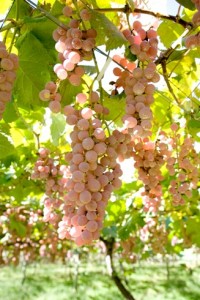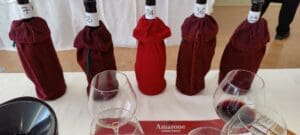Japanese Sake, plum (ume) liquors, whiskies, beers and strange tasting tomato juices. So, how about Japanese grape wines? Over past few years, I seen many attempts to bring Japanese grape wines into Singapore, with little success. Now with the Suntory folks placing their chips on Singapore, is the Land of The Rising Sun finally going to shine in the wine department here?
Few people will consider Japanese grape wine industry reputable internationally because a big part of Japan grown grapes are table grapes, for consumption in both local and foreign markets. But are these grapes native, and did they grew wild like those in Italy? They did not, and just like many countries, the first planting of grapes in Japan was linked to religion.
First account of Japanese grape vines existence revolved around a man named Gyoki in the eighth century. A faithful Buddhist and holy man, legend said Gyoki received grapes from Yakushi Nyorai, the Buddha of medicine and healing. Believing the berries were a sacred gift bestowed by Buddha, he planted the fruits on the ground of later-day Daizenji Temple, and carved a statue to worship Nyorai as the Budo Yakushi, the medicine Buddha of grapes.
The second historical account dismissed the Buddha tale and, instead, suggested that plantings brought into Japan were by Buddhist monks who travelled from China. Regardless which of these stories is true, the Budo Yakushi statue remains in Daizenji Temple of Yamanashi prefecture. Testifying the grape growing history of Japan, not for Buddha’s blessing, but for Gyoki’s effort.
Grape wines were only introduced in the 16th century when Portuguese Jesuit missionaries arrived in Japan with wines as tribute for the local feudal lords. The locals developed an interest for the alcoholic beverage and established trade relations with the Portuguese.
The fall of this trend came as quickly as it started. Shortly after in the 17th century Tokugawa shogunate era, Jesuit missionaries expelled, Christians persecuted, and all practices associated with Christianity prohibited. And along with it, the grape wine culture.
Two centuries later in the era known as Meiji Restoration, the Western influence, again, came to Japan shores. Technological modernisation and western drinking preference led to the experimental effort in 1875, when Japanese produced wines from local grape varieties. The product was no where close to the European wines, but this enterprising failure opened doorways for the later influx of European and American varieties which will shape Japan modern wine scene.
Today’s Japan is home to many grape varieties meant for fresh consumption. Only one tenth of the total planting are for wine making, and the notable varieties are the white Koshu and the red Muscat Bailey A.
The word Koshu is actually the former name of Yamanashi prefecture, thus many had inferred that this is the same variety planted by Gyoki more than a thousand years ago. Genetic studies on Koshu also proved that it is a member of the Vitis vinifera species, thus further confirming either Koshu variety or its parentage must have entered Far East through the Silk Road.
 Like Pinot Grigio, Koshu has a pinkish tone on the grape skin due to its Koshu low anthocyanin (red colour pigments) level when ripen. But its berries are notably larger compared to its European counterpart, which potentially means Koshu berries hold higher water content, and give lesser flavour. Grape skin is also thick enough to resist fungi problems when harvested late into October.
Like Pinot Grigio, Koshu has a pinkish tone on the grape skin due to its Koshu low anthocyanin (red colour pigments) level when ripen. But its berries are notably larger compared to its European counterpart, which potentially means Koshu berries hold higher water content, and give lesser flavour. Grape skin is also thick enough to resist fungi problems when harvested late into October.
Most Koshu wines are light bodied with very delicate aroma, thus swirling the glass vigorously might do a massive amount of injustice. However, Japanese wine makers are actively experimenting Koshu with different wine making techniques, and so it is very likely Koshu wines will express a myriad of forms in the near future.
For one, the 2013 Suntory Japan Premium Koshu I tasted was fermented in stainless steel tanks before ageing on the yeast (sur-lie). The resulting wine gave a distinct yuzu-like citrus aroma, which can be easily associated to classic Japanese taste. While the medium bodied weight and broad texture were balance by its crisp acidity, the acid also added a sense of astringent on the palate.
The red Muscat Bailey A is a hybrid between Muscat Hamburg and Bailey, a Vitis labrusca variety. Its creation stemmed from the need to meet fruity character that appeals to the local, while ensuring the vines will survive the harsh winter of Japan.
From my past experiences with Muscat Bailey A, its wines tasted pronouncedly like grape jelly that I used to love as a kid. And like it wasn’t weird enough, most times the wines gave a green stalkish notes. In fact, to call it a red wine is pushing the limit as the colour qualifies as a deep, dark pink. Tannins are low while acid is fairly high.
For a long time, I saw no hope in this grape variety and here it stood before me, a glass of 2012 Suntory Japan Premium Muscat Bailey A.
Fresh strawberry notes with a very slight tinge of stalkish notes, undertone of candies that quickly dissipated, as if it wanted to shed off its immaturity and prove its standing among the big boys. Swishing it around in my mouth, and its low tannins and gentle dose of acid reminded me of a fairly decent Beaujolais.
There might be some things to hope for after all.
We can all agree that the general concept of a great wine is the ability to express its place of origin, down to the very slope or hill the grapes are grown from. From the presentation given by the Suntory representative, that is the same philosophy guiding their wine making principle. But Japan is a society that seeks to master everything into an art form with their unique identity, and the Japan sense of identity certainly supersedes beyond the concept of place. It is ultimately the people, its culture, respect to self and, more importantly for others.
It is not uncommon for Japanese chefs to consider the well-being of their guests, but where will this lead them to in the area of wines?



